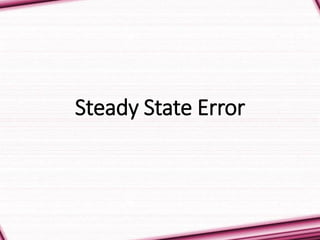
6. steady state error
- 2. Introduction • Steady-state error is defined as the difference between the input (command) and the output of a system in the limit as time goes to infinity (i.e. when the response has reached steady state). • Any physical control system inherently suffers steady-state error in response to certain types of inputs. • A system may have no steady-state error to a step input, but the same system may exhibit nonzero steady-state error to a ramp input. • Whether a given system will exhibit steady-state error for a given type of input depends on the type of open-loop transfer function of the system. • Control systems may be classified according to their ability to follow step inputs, ramp inputs, parabolic inputs, and so on. • The magnitudes of the steady-state errors due to these individual inputs are indicative of the goodness of the system.
- 3. Classification of Control Systems • Consider the unity-feedback control system with the following open-loop transfer function • It involves the term sN in the denominator, representing N poles at the origin. • A system is called type 0, type 1, type 2, ... , if N=0, N=1, N=2, ... , respectively.
- 4. Classification of Control Systems • As the type number is increased, accuracy is improved. • However, increasing the type number aggravates the stability problem. • A compromise between steady-state accuracy and relative stability is always necessary.
- 5. Steady State Error of Unity Feedback Systems • Consider the system shown in following figure. • The closed-loop transfer function is
- 6. Steady State Error of Unity Feedback Systems • The transfer function between the error signal E(s) and the input signal R(s) is )()( )( sGsR sE 1 1 • The final-value theorem provides a convenient way to find the steady-state performance of a stable system. • Since E(s) is • The steady state error is
- 7. Static Error Constants • The static error constants are figures of merit of control systems. The higher the constants, the smaller the steady-state error. • In a given system, the output may be the position, velocity, pressure, temperature, or the like. • Therefore, in what follows, we shall call the output “position,” the rate of change of the output “velocity,” and so on. • This means that in a temperature control system “position” represents the output temperature, “velocity” represents the rate of change of the output temperature, and so on.
- 8. Static Position Error Constant (Kp) • The steady-state error of the system for a unit-step input is • The static position error constant Kp is defined by • Thus, the steady-state error in terms of the static position error constant Kp is given by
- 9. Static Position Error Constant (Kp) • For a Type 0 system • For Type 1 or higher systems • For a unit step input the steady state error ess is
- 10. Static Velocity Error Constant (Kv) • The steady-state error of the system for a unit-ramp input is • The static position error constant Kv is defined by • Thus, the steady-state error in terms of the static velocity error constant Kv is given by
- 11. Static Velocity Error Constant (Kv) • For a Type 0 system • For Type 1 systems • For type 2 or higher systems
- 12. Static Velocity Error Constant (Kv) • For a ramp input the steady state error ess is
- 13. Static Acceleration Error Constant (Ka) • The steady-state error of the system for parabolic input is • The static acceleration error constant Ka is defined by • Thus, the steady-state error in terms of the static acceleration error constant Ka is given by
- 14. Static Acceleration Error Constant (Ka) • For a Type 0 system • For Type 1 systems • For type 2 systems • For type 3 or higher systems
- 15. Static Acceleration Error Constant (Ka) • For a parabolic input the steady state error ess is
- 16. Summary
- 17. Example •For the system shown in figure below evaluate the static error constants and find the expected steady state errors for the standard step, ramp and parabolic inputs. C(S)R(S) - ))(( ))(( 128 52100 2 sss ss
- 18. Example (Steady Sate Errors) pK vK 410.aK 0 0 090.
- 19. Example (evaluation of Static Error Constants) ))(( ))(( )( 128 52100 2 sss ss sG )(lim sGK s p 0 ))(( ))(( lim 128 52100 2 0 sss ss K s p pK )(lim ssGK s v 0 ))(( ))(( lim 128 52100 2 0 sss sss K s v vK )(lim sGsK s a 2 0 ))(( ))(( lim 128 52100 2 2 0 sss sss K s a 410 12080 5020100 . ))(( ))(( aK